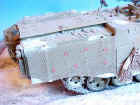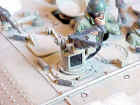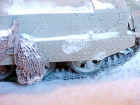|
The troop carrier Achzarit ("cruelty" in Hebrew) was designed according to the traditional Israeli principles: use of the existing material up to the limit of its useful life and adaptation to the new requirements of combat.
The combat experience in Lebanon and the introduction of great quantities of lightweight antiaircraft weapons (Soviet RPG rockets, Soviet AT missile launchers and French Milan) by the Palestinian troops and the Syrian Armed Forces, evidenced the need to have more powerful and strongly armored troop carriers than the traditional Zelda (M 113).
The experience of other countries in the development of troop carriers from tank chassis (Kangaroo in World War II, and Israeli Nag Ma Sho't on Centurion chassis, etc), which means using the existing platforms and the thick original armor of the tank, had a strong influence on the Tsahal (Israeli Army) who decided to develop a series of troop and engineers carriers taking as a basis the chassis of those tanks no longer in operation.
From that point on, the great quantity of T 54 and T 55 available on inventory after the wars with Arab countries (whose performance did not satisfy the Israeli) led logically to the development of a specialized vehicle designed from original Soviet chassis.
The original engine was replaced by an adapted version of that used for the family of the M109 auto propelled howitzer, more compact and efficient, given the local weather and terrain conditions. This fact made it possible to add a rear exit for the troop, thus enabling troop disembarkment under the protection of the vehicle.
The upper hull was completely redesigned, with the addition of several hatches for the use of Mag's for close defense (generally three), and a 60 mm mortar, which is standard in all Israeli armor vehicles. The only drawback being the fact that the soldier is unprotected when using these weapons.
But this drawback is partly offset by the addition of a fire post in the front part (which is controlled from the inside) with a Mag, similar to that of the Marder 1 and the first VCTP.
In addition, like in all Israeli armored vehicles, this Achzarit is equipped with two smoke grenade launchers in the front part of the vehicle.
For protection of the crew, some Mag'Ach armor plates and Toga sheets were added to the original armor.
This unit was developed as a heavyweight troop carrier, specifically as an assault vehicle. Its general design is intended for depth assault operations, in a great scale war scenario (a hypothetical invasion to Syria, for instance) in order to easily break through the enemy lines.
The Israeli company NIMDA was in charge of its development and production. There are currently 300 / 400 Achzarit units in service.
Configuration
Low profile, 2 mts high maximum. Reinforced sides and roofed combat compartment. Transversally mounted engine.
Rear view
Engine mount on the rear left side of the vehicle. This transversal mount leaves room for a narrow aisle that ends in a long hatch and exit ramp, both hydraulically activated. The soldiers have to exit one by one.
Crew of three seated at the front: the driver at the left, commander at the center, gunner on the right. There are hatches for all three people plus other two for the troop (this vehicle can carry up to 8 soldiers). There is also a long bench in the rear part of the compartment, just before the engine mount, for 3-4 men. On the right there is a folded seat and other three alongside the right side.
Protection
This unit can resist any impacts from HEAT or piercing ammunition. It weights 44,000 kg. Out of these 44,000 kg, 14 tons are of additional passive composed armor (Mag'Ach and Toga sheets) on the original armor. This protection extends from the front arch through all the combat compartment. This vehicle was designed in a way that all component parts contribute to the general protection of the vehicle. The diesel fuel storage tanks on both rear sides of the combat compartment also serve as armor.
It also features a Spectronix fire extinguishing and detector system (Halon gas). For active protection, this unit carries two Israel Mil Industries CL-3030 instant grenade launchers. It also has a gasoline injection spray system on the exhausts to generate an additional smoke cloud, and individual NBC protection for both crew and troop.
Fire capacity
 Rafael Overhead Weapon System (OWS), 160 kg, with minimum internal space requirements. Standard weapons, FN 7.62 mm M240 machine guns which are man controlled from inside the vehicle under the armor protection. 25 d optical system with a x1 mag image magnification and assisted aiming system. Both systems have night vision capacity. Rafael Overhead Weapon System (OWS), 160 kg, with minimum internal space requirements. Standard weapons, FN 7.62 mm M240 machine guns which are man controlled from inside the vehicle under the armor protection. 25 d optical system with a x1 mag image magnification and assisted aiming system. Both systems have night vision capacity.
 Optional weapons include a 60 mm mortar mounted on the roof, which can fire AP ammunition, flares and smoke. Optional weapons include a 60 mm mortar mounted on the roof, which can fire AP ammunition, flares and smoke.
Mobility
The original model was equipped with a Detroit Diesel 8V-71 TTA, 650 hp engine with Allison XTG-411-4 transmission. The engine mount is based on that of the M109 SPH. When enough funds are available, this engine mount will probably be improved (NIMDA was close to win the bid to re engine the Czech T-72)
Meanwhile, the power-to-weight ratio is only 14.77 hp/lt. The NE. versions of this Achzarit unit have a 8V-92TA/DDC III, 850 hp engine, with a XTG-411-5A transmission, which generates a 18.31 hp/lt power-to-weight ratio.
The suspension system was improved with the addition of torsion bars and additional shock absorbers.
The original running gear and tracks remain the same (the addition of the Merkave running gear and tracks is being studied for future versions of the Achzarit).
Operational organization
 Used in the northern area, in the Golan Heights. Used in the northern area, in the Golan Heights.
Battalion: 36 standard vehicles, 1 command version.
Additional: mechanical support M113 APC.
 Used at the Infantry Training Center, Negev Desert (with a reduced number of 850 hp versions). Used at the Infantry Training Center, Negev Desert (with a reduced number of 850 hp versions).
They usually operate in groups of three vehicles. They take mutual support positions, interchanging firing positions. Two of these vehicles usually leave the protection position and reach the target at high speed by surprise, taking advantage of the terrain features. With the vehicle still in motion, although at a slower pace, the soldiers leave the vehicle one by one. Meanwhile, the third vehicle provides fire support.
|
The model
This model was built on a T-55 Esci chassis, using all available drawings and pictures.
The upper hull is of resin, with cut out details and other additions produced with plastic, aluminum sheets, epoxy for curved areas and putty. All hatches were made with the same materials.
The armor skirts are of plastic sheets with stretched plastic bolts. The Toga-type armor skirts (pierced) were taken from the Verlinden M113 Zelda kit, and then modified.
The machine guns are taken from Academy kits (Merkava and M 60 Blazer). The remote firing post is made of plastic, epoxy putty and aluminum sheets, the machine gun is a duplication of that from the Tamiya Merkava Y.
All additional volumes, canvasses and nets are produced with the usual materials. All tracks are from Friulimodelismo. Grenade launchers are of plastic sheet and epoxy putty.
|

|
|

|
|

|
Painting
This model was entirely painted with Testors Model Masters Israeli Tank gray.
I applied several washes and soft dry brush with Armor Sand and then weathered with metal . The bolts and hinges are generally painted red (usually used to highlight mobile parts and / or frequent maintenance).
All serial numbers and signals are Academy.
|